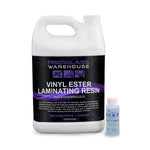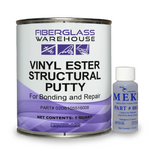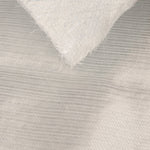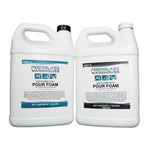You have no items in your shopping cart.
Working with a gel coat can be a tricky process. Many problems can arise including alligatoring, blisters, cracks, fisheyes or dimples if you are not careful. In this guide, we will discuss some of these most common gel coat problems and provide tips for preventing these issues from happening in the first place. Whether you are a hobbyist or a professional, read on for the information you need to get your gel coat looking its best. Also included in this guide is some very basic info on repairing these issues if they arise.
What is gel coat? Gel Coat is a formulated polyester resin that is designed to be used as a protective or decorative coating on fiberglass parts and in molds. They are a two-part system that cures at room temperature with the use of an MEKP catalyst. It creates a beautiful high-quality finish when applied correctly. Our gel coat is a superior grade ISO NPG polyester resin.
If you are using a spray gun, read all the instructions for both the spray gun and the gel coat. You will want to make sure to work in an area that is warm enough and not too humid, to catalyze the gel coat properly and also ensure the surfaces have been properly prepared.
Alligatoring
Alligatoring (crazing) is a common issue with gel coat and appears as a wrinkled alligator skin texture on the surface. It can occur when the gel coat is applied too thin or if the gel coat is insufficiently cured. It can also appear when laminating before the gel coat is cured enough.
It is necessary to apply at least 15 mils of gel coat, whether it is in one pass or in several passes. Be very careful if you are using a brush. It is easy to have thin sections of gel coat when not using spray equipment. When the next layer of either gel coat or laminating resin is applied, the styrene will react with that second layer causing a wrinkly appearance. This can also occur if the first coat is not sufficiently cured before adding the laminating resin.
Make sure the correct amount of catalyst is used and that the gel coat and hardener are mixed well. Do not over or under-catalyze. Also, work in temperatures that are at least 70 degrees Fahrenheit to ensure that the gel time is not too long.
Alligatoring can be repaired by properly sanding and polishing the area, or if necessary, reapplying a new layer of gel coat. It sounds easy but it can be quite a bit of work depending on the size of the repair area.
Blisters
Blisters occur when gel coat fails to cure properly and bubbles form underneath the surface. There could be just a couple of them or there might be hundreds on the surface. It looks similar to a blister on the human skin. Blistering can be caused by various factors, such as improper gelcoat application, too long of a cure time or adding too much or too little MEKP catalyst. A gel coat layer that is too thin can cause blistering. Gel coats are fairly water permeable and if there are small voids in the gel coat, it will allow water in. This water will have a chemical reaction with the resin and cause it to expand.
Blister repair requires breaking open the blister to release the liquid inside, washing the area with a solvent and grinding out the decomposed material. It is important to make sure all the acidic material is washed away before sealing, fairing, sanding and re-gelcoating.
For more general info on blister repair, go here- https://fiberglasswarehouse.com/blogs/news/boat-hull-blister-repair
Spider Cracks
Spider cracks are thin lines that run through gel coat surfaces. They can radiate from a central point or in circles. They are usually caused by flexing under stress or applying too much gel coat. Gel coat should be applied between 15-20 mils (in several passes) to avoid creating a gel coat layer that is too thick. The cracks may be cosmetic only which are easier to fix. But they may go deeper and be more difficult to repair.
Spider cracks can usually be repaired by masking off the repair area, cleaning it with a solvent, sanding or dremeling the area, using a filler and resin to fill the area and reapplying the gel coat.
For more information on repairing cracks, click here- https://fiberglasswarehouse.com/blogs/news/gel-coat-repair-series-cosmetic-scratches-or-cracks
Dimples
Dimples are a depression on the surface of the object similar to depressions in a golf ball or a human dimple. Dimples can be prevented by applying gelcoat evenly and in thin layers. It is also important to keep your work area and spray equipment free of contamination. It is necessary to make sure there is no moisture, oils, dirt or solvents that can affect the gel coat. The gel coat and catalyst need to be properly mixed and added at the proper ratio.
If a dimple appears, it can be repaired by sanding the area down and reapplying gel coat to fill in the depression. The repair may be more extensive, needing a filler and resin as well to fair the area. It just depends on how deep the dimples are in the gel coat surface.
Dull or Soft Spots
Dull spots on gel coat surfaces can be a result of exposure to chemicals or water damage. The gel coat can become dull from oxidation. Soft spots can be caused by uneven gel coat application, catalyst either poorly mixed or not enough added.
Dull gel coat can be restored by washing, wet/dry sanding and using polishing compounds to bring back the luster. A new layer of gel coat could be applied if the color does not come back the way you desire.
Soft spots would require more work to repair. It would need to be sanded possibly down to the fiberglass layer. A fairing putty can be used to fill the hole or you can make your own using resin and a filler. Once the spot is filled, it can be sanded and gel coat can be applied.
Delamination
Delamination occurs when gel coat separates from a substrate such as fiberglass, causing discoloration and curling of the gelcoat edges. You may see the reinforcement below the gel coat layer. Delamination can be prevented through proper application technique and making sure the work area and equipment is free from contamination.
If delamination occurs, it must be repaired with extra care to ensure good adhesion between the gelcoat and the substrate.
Fisheyes and Pinholes
Fisheyes are small circular depressions on the gel coat surface that present themselves if there is contamination including water, oil, silicone or dust. Fisheyes also occur if gel coat is applied too thin either by spray gun or brush. Another reason fisheyes may appear in the gel coat is if too much mold release was used on the mold. Fisheyes can be avoided by making sure the spray gun, brushes or whatever is used to apply the gel coat is completely clean. This includes draining the air lines and making sure the lubricating materials for the spray equipment are not contaminated. If you are using a brush, make sure they are completely free of contaminates.
Pinholes occur when gel coat fails to cure properly. They are tiny holes in the gelcoat. Pinholes can occur when gel coat is sprayed too quickly or if not enough pressure is added when applying.
Both fisheyes and pinholes can be repaired through proper sanding, cleaning the repair area and patching with gel coat. It is important to get rid of the original contaminates before reapplying gel coat.
Conclusion
With this guide, we hope that you can now identify and address the most common gel coat issues with ease. By understanding and following these tips, you can make sure your gelcoat is applied correctly and kept looking its best. With a little time, effort and know-how, your gel coat will be easy to apply and last for years to come.
For more info on gel coats and how to prepare and apply, you can read our basic gel coat guide here- https://fiberglasswarehouse.com/blogs/news/basic-gel-coat-guide
Contact us today for gel coat troubleshooting help either by email sales@fiberglasswarehouse.com or by phone at 1-833-669-7899
comments (7)
-

-
 Fiberglass Warehouse
Fiberglass Warehouse@R Bryden- Somehow it was damaged. Probably hit something and the underlying fiberglass is damaged. You will need to cut out the bad fiberglass and re-fiberglass it. Do you know what type of fiberglass was used before? And Resin?
-
 R Bryden
R BrydenOn the foredeck of my two year old rowing shell I have a 6” diameter soft spot that is alligatoring and is forming a depression.
Any thoughts on cause and remediation? -
 Fiberglass Warehouse
Fiberglass Warehouse@Jhovani – Did you add extra styrene to the gel coat? Too much styrene can turn it yellow. Or it got too hot during the curing process. Hard to say what else it could be.
-
 Jhovani H
Jhovani HI recently sprayed a tool with two coats of clear silver ,silver flake, white and finally the black backing after lamination and the de molding process the part looked yellowish can’t figure out what was my issue










I have my dads canoe which he bought in 1964 for 200 USD when he was 16. For most of those years it was protected but now it has spent a couple decades outside and the gel coat is pretty bad. We bashed it around a lot of white water when I was a kid, so it"s pretty banged up too. I have a lot of great memories in it and I would like to restore it. I have only a few hours experience with fiberglass and none with gel coats. I think he did some quick repairs and just stuck new fiberglass over top the original gel coat and it is coming off. can send some pictures. I am willing to put in the work and buy the materials. If that means sanding off the entire gel coat and repairing what is underneath – so be it.